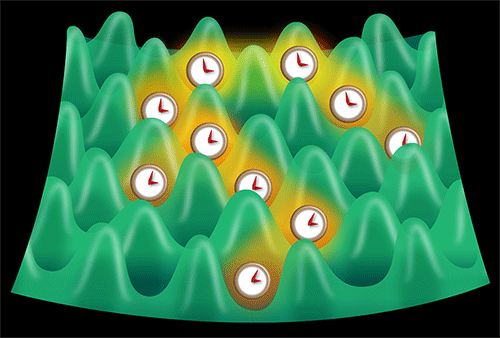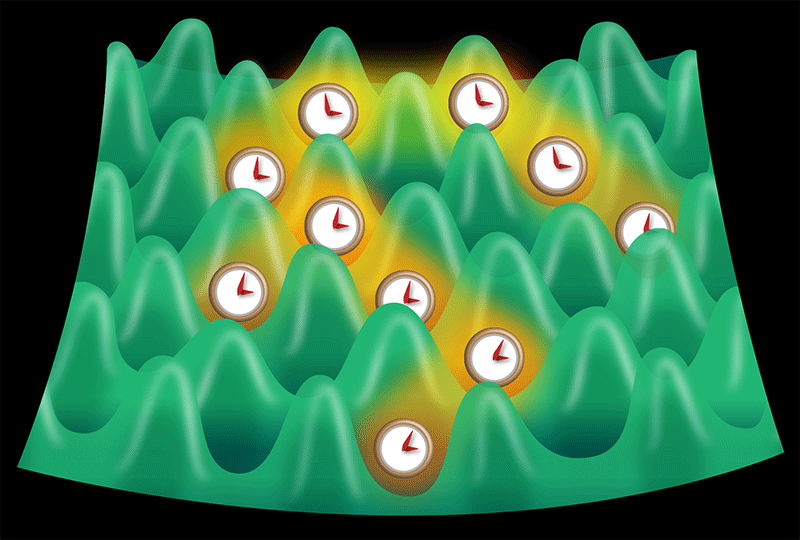A Boost in Precision for Optical Atomic Clocks
Today’s most precise atomic clocks are based on strontium, ytterbium, and other alkaline-earth (or alkaline-earth-like) atoms [1]. These elements have ultranarrow transitions at optical frequencies, providing stable and precise frequency standards for measuring time, as does the quartz oscillator in a wristwatch. Alkaline-earth frequency standards are almost a thousandfold more precise than the cesium atomic clocks that are currently used to define the second. A team led by Jun Ye at JILA in Colorado has now set a new record among optical atomic clocks by demonstrating a strontium (Sr) clock with a relative precision of 2.5×10−19 [2]—equivalent to an imprecision of 100 ms over the estimated lifetime of the Universe. Their device, which is based on thousands of ultracold Sr atoms confined in a 3D optical lattice, surpasses the previous “best” optical clock [3] by a factor of 1.4 in precision.
Given that clocks already have such astonishingly high levels of precision, why strive for more? To a scientist, the answer is simple: With each improvement come new vistas for scientific exploration and discovery. Phenomena that were once impossible to study or questions about nature that seemed rhetorical suddenly morph into lines of experimental research. Already, optical clocks are being proposed as new tools to detect gravitational waves [4], to place bounds on the variation of fundamental constants [5], and to understand the very nature of time itself. Improvements in optical clocks can also lead to new technologies, including GPS systems with subcentimeter accuracy, deep space navigation, more secure telecommunications, new methods of exploring oil and gas reserves, and more accurate means of detecting tectonic motion.
To place the recent work by Ye and co-workers [2] in context, it is useful to recall the basic ingredients for a fundamental frequency standard. First, one needs an atomic transition with a high frequency and a narrow linewidth, the combination of which allows the frequency to be pinpointed accurately. Second, this transition must be measureable over a sufficiently long time, as averaging many measurements together leads to higher precision. Third, an ultrastable oscillator such as a laser or a microwave source is needed to excite the atoms. An additional consideration is that by simultaneously interrogating N indistinguishable atoms, one can decrease by a factor of N1∕2 the so-called quantum projection noise (QPN), which sets a limit on the precision of the clock.
With these considerations in mind, several research groups have developed atomic clocks based on an extremely narrow optical transition of Sr [6]. This transition has a frequency of around 429 terahertz (THz) and a linewidth well below a hertz. Moreover, the QPN limit can be improved by performing measurements on millions of these atoms confined within an optical lattice [7]. Ye and colleagues put these ingredients in place by cooling around 10,000 Sr atoms to a temperature of 15 nK and loading them into a 3D optical lattice. The researchers then perform spectroscopy of the clock transition by exciting the 429-THz transition with an ultrastable laser.
To reach a new level of precision and stability, however, the researchers had to battle several sources of systematic and statistical uncertainty. Broadly, the contributions to this uncertainty can be classified as “single particle” or “many particle.” Single-particle effects may come from frequency noise in the excitation laser or from variations in the local electromagnetic field that make the local energy landscape vary from atom to atom. The result of these spatial inhomogeneities is that atoms in different regions of the lattice exhibit transitions at slightly different frequencies, and this spread of transition frequencies reduces the precision of an ensemble measurement.
By contrast, many-particle effects correspond to interactions among the atoms, which lead to density-dependent frequency shifts. This issue would seem to present a dilemma: Adding atoms to the optical lattice provides a larger ensemble and therefore a higher precision measurement. But it also exacerbates the role of atom-atom interactions, which modify the clock-transition frequency in direct proportion to the atomic density [8, 9].
Fortunately, Ye’s group is able to solve this many-particle problem by cooling the Sr atoms to below a microkelvin. As the authors showed in 2017 [3], the cooled atoms form a quantum degenerate gas, in which they avoid one another by self-organizing into an insulating phase with precisely one atom at each site in the optical lattice. Interactions between the atoms are dramatically suppressed within this insulating phase—an example of how the formation of a collective quantum phase can allow for a more precise measurement of a single-particle property.
This then leaves single-particle effects as the dominant source of imprecision. As explained above, these effects cause atoms in different parts of the lattice to experience a different energy landscape and therefore to exhibit different transition frequencies. To address this frequency spread, Ye and colleagues measure the clock frequency at different locations in the lattice by combining ultraprecise optical spectroscopy and high-spatial-resolution imaging. The resulting frequency map shows gradual variations in the Sr clock frequency across the extent of the atomic ensemble (Fig. 1), allowing the researchers to diagnose and cancel various sources of inhomegeneities. Specifically, they are able to cancel minute misalignments in the lattice lasers that lead to spatially varying clock frequencies, an effect that may have gone unnoticed in previous experiments. In addition, the lattice laser is known to perturb the frequency of the atoms. The team corrects this problem by using the imaging technique to find the “magic wavelength” of the lattice laser at which this effect vanishes. Finally, they can calibrate the frequency noise in their excitation laser using this spectroscopic imaging technique.
This new technique will no doubt lead to further improvements in optical atomic clock precision and stability. The work is also notable for bringing together ultraprecise optical spectroscopy and high-resolution atom imaging, two of the most transformative innovations in ultracold atomic physics over the last decade. The imaging demonstrated by Ye and co-workers is still short of having single-site resolution, the realm of a method known as quantum gas microscopy. But this goal is feasible with moderate improvements in the imaging system. With single-site resolution in play, this new clock could also be used as an ultrasensitive probe of long-range interactions and quantum correlations in exotic quantum phases, which are predicted to exist in alkaline-earth lattice gases at low temperatures.
This research is published in Physical Review Letters.
References
- A. D. Ludlow, M. M. Boyd, J. Ye, E. Peik, and P. O. Schmidt, “Optical Atomic Clocks,” Rev. Mod. Phys. 87, 637 (2015).
- G. E. Marti, R. B. Hutson, A. Goban, S. L. Campbell, N. Poli, and J. Ye, “Imaging Optical Frequencies with 100 𝜇Hz Precision and 1.1 𝜇m Resolution,” Phys. Rev. Lett. 120, 103201 (2018).
- S. L. Campbell et al., “A Fermi-Degenerate Three-Dimensional Optical Lattice Clock,” Science 358, 90 (2017).
- S. Kolkowitz, I. Pikovski, N. Langellier, M. D. Lukin, R. L. Walsworth, and J. Ye, “Gravitational Wave Detection with Optical Lattice Atomic Clocks,” Phys. Rev. D 94, 124043 (2016).
- T. Rosenband et al., “Frequency Ratio of Al+and Hg+ Single-Ion Optical Clocks; Metrology at the 17th Decimal Place,” Science 319, 1808 (2008).
- See, for example, Refs. [27–32] in Fritz Riehle, “Towards a Redefinition of the Second Based on Optical Atomic Clocks,” C. R. Phys. 16, 506 (2015).
- N. Poli, C. W. Oates, P. Gill, and G. M. Tino, “Optical atomic clocks,” Riv. Nuovo Cimento 36, 555 (2013).
- A. Bennett, K. Gibble, S. Kokkelmans, and J. M. Hutson, “Atomic Clock Measurements of Quantum Scattering Phase Shifts Spanning Feshbach Resonances at Ultralow Fields,” Phys. Rev. Lett. 119, 113401 (2017).
- E. L. Hazlett, Y. Zhang, R. W. Stites, K. Gibble, and K. M. O’Hara, “s-Wave Collisional Frequency Shift of a Fermion Clock,” Phys. Rev. Lett. 110, 160801 (2013).





